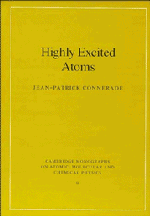Book contents
- Frontmatter
- Contents
- Preface
- 1 Closed shells, sphericity, stability and ‘magic numbers’
- 2 Rydberg states
- 3 Quantum defect theory for bound states
- 4 Atomic f values
- 5 Centrifugal barrier effects
- 6 Autoionisation
- 7 Inner-shell and double-excitation spectra
- 8 K-matrix theory of autoionising resonances
- 9 Atoms in strong laser fields
- 10 Statistical methods and ‘quantum chaology’
- 11 Atomic effects in solids
- 12 Atomic clusters
- References
- Index
8 - K-matrix theory of autoionising resonances
Published online by Cambridge University Press: 19 September 2009
- Frontmatter
- Contents
- Preface
- 1 Closed shells, sphericity, stability and ‘magic numbers’
- 2 Rydberg states
- 3 Quantum defect theory for bound states
- 4 Atomic f values
- 5 Centrifugal barrier effects
- 6 Autoionisation
- 7 Inner-shell and double-excitation spectra
- 8 K-matrix theory of autoionising resonances
- 9 Atoms in strong laser fields
- 10 Statistical methods and ‘quantum chaology’
- 11 Atomic effects in solids
- 12 Atomic clusters
- References
- Index
Summary
Introduction
The present chapter provides a summary of the basic principles of Wigner scattering or K-matrix theory, followed by examples of its application to atomic spectra, and more specifically to the study of interacting autoionising resonances, for which it happens to provide a very suitable analytic framework, within which most of the important effects can be illustrated rather simply. We concentrate on an elementary account of basic principles rather than on the most complete algebraic formulation, because the theory in its full generality becomes rather forbidding. Thus, when only a small number of channels needs to be included in order to illustrate an effect, suitable references are indicated, where the reader can find a fuller treatment. We also make the fullest possible use of analytic methods, which allow one to pick out a number of significant effects without detailed numerical computations: this turns out, rather remarkably, to be possible only for atoms, and this is a consequence of the asymptotic Coulomb potential.
Atoms therefore provide an excellent testing ground for the details of Wigner's theory. Wigner's [370] S-matrix theory postulates the existence of a Schrödinger-type equation, but actually requires no explicit knowledge of its solutions. In this sense, it is regarded as the most general formulation of scattering theory (and is more general than MQDT). One can even handle photon decay channels, although no explicit wavefunction can be written for photons. They appear in scattering theory as weaklycoupled radiative channels, and examples will be given in the present chapter.
- Type
- Chapter
- Information
- Highly Excited Atoms , pp. 246 - 324Publisher: Cambridge University PressPrint publication year: 1998



